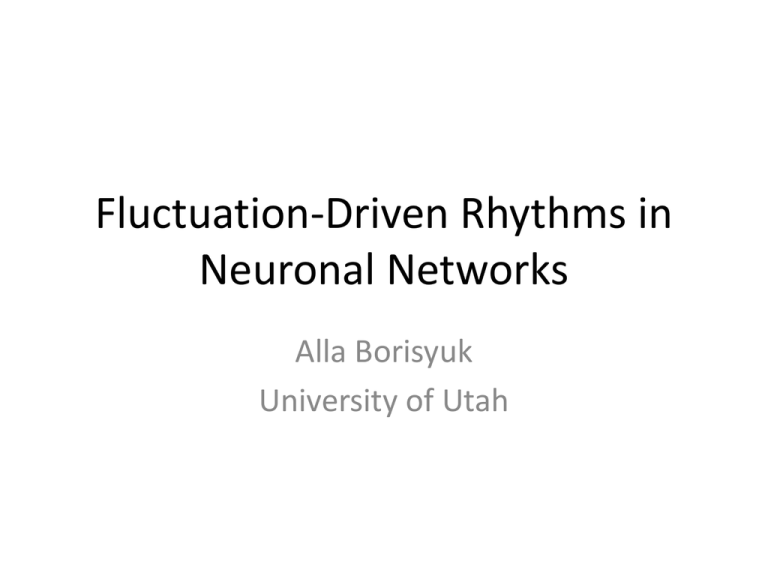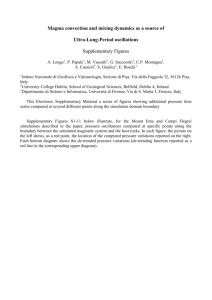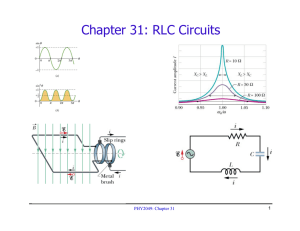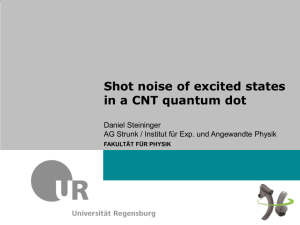Fluctuation-Driven Rhythms in Neuronal Networks Alla Borisyuk University of Utah
advertisement

Fluctuation-Driven Rhythms in Neuronal Networks Alla Borisyuk University of Utah Plan • Biological examples of rhythms • Model I: Noise as kindling - building the model(s) - analysis: model reduction - benefits of noise • Model II: Rhythm from a “noisy crowd” - building the model - analysis: parameter constraints - (unexpected) predictions Example 1: Pre-Bötzinger complex • Area in brainstem Pre-Bötzinger complex • Area in brainstem • Control of respiratory rhythm From Del Negro et al. 2001 Pre-Bötzinger complex • Area in brainstem • Control of respiratory rhythm • Frequency can be modulated over large range Pre-Bötzinger complex • Area in brainstem • Control of respiratory rhythm • Frequency can be modulated over large range Mechanisms? Driven by a pacemaker (oscillator)? • ~5% of neurons are pacemakers • Blocking putative pacemaking mechanism preserves the rhythm Pre-Bötzinger complex • Area in brainstem • Control of respiratory rhythm • Frequency can be modulated over large range Mechanisms? Emergent network property? Role of noise? Emergent network property Feldman and Del Negro 2006 Emergent network property Role of noise as a control mechanism? Large range of frequencies? Feldman and Del Negro 2006 Example 2: Developing spinal cord • Population oscillations (O’Donovan and Chub 1997) Developing spinal cord • Population oscillations (O’Donovan and Chub 1997) • No bursters, pacemakers <5% • Episode builds up from individual events Developing spinal cord • • • • • Population oscillations (O’Donovan and Chub 1997) No bursters, pacemakers <5% Episode builds up from individual events Effectively excitatory connections Role of synaptic depression or spike-frequency adaptation • Explored in ad-hoc firing rate models (Tabak et al. 2000, 2001) and spiking models with heterogeneity (Vladimirski et al., in press) Developing spinal cord • • • • • Population oscillations (O’Donovan and Chub 1997) No bursters, pacemakers <5% Episode builds up from individual events Effectively excitatory connections Role of synaptic depression or spike-frequency adaptation • Explored in ad-hoc firing rate models (Tabak et al. 2000, 2001) and spiking models with heterogeneity (Vladimirski et al., in press) Same model as Pre-Botzinger complex Example 3: Insect Antennal Lobe Mushroom body Lateral protocerebrum Antennal lobe Antenna: 60 000 receptors • Analogue of the olfactory bulb in mammals • First stage of processing of the olfactory input • Activity of cells represents olfactory stimuli (spatially and temporally) www.neurobiologie.fu-berlin.de/galizia/ Properties of the rhythm Individual Neurons: no oscillation in spike trains Power spectrum Population: oscillation 20-30 Hz No peak in power spectrum 25 Hz Consequently: low correlation between population and ind. neurons Bazhenov et al. 2001 Properties of the rhythm Individual Neurons: no oscillation in spike trains Power spectrum Population: oscillation 20-30 Hz No peak in power spectrum 25 Hz Subthreshold voltage is more oscillatory Bazhenov et al. 2001 Properties of the rhythm Individual Neurons: no oscillation in spike trains Power spectrum Population: oscillation 20-30 Hz No peak in power spectrum 25 Hz Mechanisms? Subthreshold voltage is more oscillatory Bazhenov et al. 2001 The Role of the Antennal Lobe • First stage of processing of the olfactory input • Spatial, rate, and temporal coding of odors • Odor representation in the AL changes with learning Odor 1 Before training food! After training Odor 2 The Role of the Antennal Lobe • First stage of processing of the olfactory input • Spatial (rate), and temporal coding of odors • Odor representation in the AL changes with col learning Odor 1 Odor 2 Before training food! After training color = activity level The Role of the Antennal Lobe • First stage of processing of the olfactory input • Spatial, rate, and temporal coding of odors • Odor representation in the AL changes with learning Odor 1 Before training food! After training Odor 2 The Role of the Antennal Lobe • First stage of processing of the olfactory input • Spatial, rate, and temporal coding of odors • Odor representation in the AL changes with learning • AL network itself is modified with learning (Farooqui et al 2003) The Role of the Antennal Lobe • First stage of processing of the olfactory input • Spatial, rate, and temporal coding of odors • Odor representation in the AL changes with learning • AL network itself is modified with learning (Farooqui et al 2003) What changes in the network? Model I: Noise as kindling • Noisy spiking model can be used to produce the rhythm? • Analyze using mean-field reduction • Noise amplitude controls the frequency of oscillations Spiking models Leaky integrate-and-fire with hyperpolarization A. Synaptically-driven B. Calcium-mediated • Reduce to a mean-field description • Look for oscillatory solutions Nesse, Borisyuk, Bressloff (2008) Spiking models Leaky integrate-and-fire with hyperpolarization A. Synaptically-driven B. Calcium-mediated Spiking models Below threshold fast Adaptation v v I h s(t ) x(t ) External inputs (noise) v(t ) v(t ) v r r v Network connections Spiking (reset) h is slow and different in two models (introduced below) Individual cells No intrinsic bursts Connections All-to-all connections: each cell receives the same population input s s sw Each spike produces an alpha-function s w as w N (t ti j ) i j Noise External inputs modeled as white noise arriving at synapses with time constant x (t) x x x y x y y x (t ) A: Synaptically-driven adaptation h h slow h ah ( s(t ) x(t )) A: Synaptically-driven adaptation v i v h vi I hi h i hi ah ( s xi ) s s w s sw as w N x i x xi y i yi y s xi ; vi (t ) (t ti j ) i j yi x i (t ) vi (t r ) vr Population bursting Spikes build-up Increase in noise amplitude increases burst frequency Further increase in noise amplitude abolishes bursting Noise controls bursting Building mean-field model v h v i vi I hi h i hi ah ( s xi ) s s sw <x>=0 τv« τs, τx« τh , large N input-output (f-I) curve f(x) s w as w N x i x xi y i yi y f(I-h+s+x) s xi (t ti j ) i j yi x i (t ) <f> ensemble average Building mean-field model h h ss w f w h ah s s w w as f f ( I h s x) p( x)dx with p( x) - Gaussian with st. dev. / 2 Ornstein-Uhlenbeck process x x x x y y y x (t ) p(x) A: Mean-field model • 3-dimensional model h h ss w w h ah s s w w as f • Find steady states (between 1 and 3) • Linear stability Bifurcation diagram (schematic) s σ Varying noise and I Varying noise Varying I Burst rate 2.5 0.5 0.75 B: Calcium-mediated adaptation slow h h h h (c ) c c ac c (t t j ) j B: Mean-field model • 4-dimensional model h h cc s ww s h h (c ) c f (s h I ) s w w as f Produces bursting Onset of bursting through SNIC • Even larger range of burst frequencies Conclusions • Population bursting exists for a range of noise amplitudes • Mean-field behavior matches the spiking model • Onset of periodic solution through Hopf bifurcation or SNIC, depending on details of spiking model • Frequency can be controlled by changing σ • The model can be used for the spinal cord too Model II: Rhythm from a “noisy crowd” Antennal Lobe • • • • E,I cells (800, 4000 bee; 900, 300 locust) Connectivity is not well known (E→E ?) Some I cells have wide arborization Fast excitation (Ach), fast inhibition (GABAA), slow inhibition (hystamine?) Oscillations and odor coding • Mechanisms proposed in earlier models (e.g. Bazhenov et al. 2003) • Also included: sequence of E ensembles as a stimulus code Oscillations and odor coding • Mechanisms proposed in earlier models (e.g. Bazhenov et al. 2003) • Also included: sequence of E ensembles as a stimulus code • Alternatively: mostly spatial code, oscillations as bi-product of the network activity Model Theory: (Brunel,Hakim(1999); Brunel,Wang(2003)) • Leaky integrate-and-fire (LIF) • Random connections with fixed probability • Synaptic delays • Poisson excitatory external input • Assume asynchronous state (constant population activity), look for onset of oscillations • Near onset: population oscillation with noisy neurons Numerics: LIF, Morris-Lecar Tuning the model Looking for onset of oscillations, i.e. assume νE,I(t)= ν0E,I(1+εE,Ieiωt) Brunel and Wang, 2003 Tuning the model Looking for onset of oscillations, i.e. assume νE,I(t)= ν0E,I(1+εE,Ieiωt) νE νI Brunel and Wang, 2003 Tuning the model Looking for onset of oscillations, i.e. assume νE,I(t)= ν0E,I(1+εE,Ieiωt) ν E → sE νI → sI Brunel and Wang, 2003 Tuning the model Looking for onset of oscillations, i.e. assume νE,I(t)= ν0E,I(1+εE,Ieiωt) νE → sE → Isyn,E νI → sI → Isyn,I Brunel and Wang, 2003 Tuning the model Looking for onset of oscillations, i.e. assume νE,I(t)= ν0E,I(1+εE,Ieiωt) νE → sE → Isyn,E → νE νI → νI → sI → Isyn,I Iext Brunel and Wang, 2003 E I νE,I(t)= ν0E,I(1+εE,Ieiωt) Equation for frequency: ΦI Λ sin ΦE atan Λ cos ΦE 1 E I νE,I(t)= ν0E,I(1+εE,Ieiωt) Equation for frequency: ΦI Λ sin ΦE atan Λ cos ΦE 1 where Φ ω depend on synaptic time constants Φω ωτl atan ωτ r atan ωτ d E I νE,I(t)= ν0E,I(1+εE,Ieiωt) Equation for frequency: ΦI Λ sin ΦE atan Λ cos ΦE 1 where Φ ω depend on synaptic time constants Φω ωτl atan ωτ r atan ωτ d E I νE,I(t)= ν0E,I(1+εE,Ieiωt) Equation for frequency: ΦI Λ sin ΦE atan Λ cos ΦE 1 where Φ ω depend on synaptic time constants, Λ depends on the relative strength of connections Λ X IE X EI /X II E Λ sin ΦE atan Λ cos ΦE ΦI I 1 Biological constraints: Phase: population I lags by π/2 Frequency: f = ω/(2π) = 20 to 30 Hz ΦI 2 25 ωτlI atan ωτ rI using atan(x)<x atan ωτ dI 2 E I Λ sin ΦE atan Λ cos ΦE ΦI 1 Biological constraints: Phase: population I lags by π/2 Frequency: f = ω/(2π) = 20 to 30 Hz ΦI 2 25 ωτlI τ lI atan ωτ rI τ rI τ dI atan ωτ dI 10 msec 2 Need: τ lI τ rI τ dI 10 msec Biological estimate: τ lI τ rI τ dI Firing rate is too high E I 7 msec Need: τ lI τ rI τ dI 10 msec Biological estimate: τ lI τ rI τ dI Firing rate is too high E 7 msec I Solution: Add E-E connections Solve equations for frequency numerically E-E connections reduce oscillations rate RHS Prediction: E-E connections without E-E with E-E frequency Blocking inhibition • Reducing strength of inhibition abolishes the oscillations (asynchronous firing is the only solution) • Biologically: MacLeod & Laurent (1996), Mwilaria et al (2008) Change in odor concentration Amplitude Frequency • Biologically: Increasing concentration increases amplitude of oscillations, but leaves frequency unchanged (Stopfer et al. 2003) • Concentration ≈ Firing rate of input input input Short-term memory With repeated presentations of a stimulus • Cells are more synchronized • Firing rate of individual cells decreases • Oscillation frequency remains the same (Stopfer, Laurent 1999) What changes in network connectivity could be causing these? Short-term memory ΦI Λ sin ΦE atan Λ cos ΦE Frequency depends on Λ 1 X IE X EI /X II X EE X IE In E-E network: and X EI X II On the other hand, strength of connection is a bifurcation parameter Prediction: learning increases strength of both excitation and inhibition, keeping the balance Slow patterns Biologically: Stimulus- and neuron- specific slow patterns of activity and inactivity; picrotoxin-incensitive Bazhenov et al. 2001 Slow patterns Biologically: Stimulus- and neuron- specific slow patterns of activity and inactivity; picrotoxin-incensitive Suggestion: Neurons are driven between “ON” and “OFF” states (perhaps bistable?) by fluctuations in the receptor neurons’ activity A neuron is able to participate in the network activity only during the “ON” state Summary Properties: • Oscillatory population, non-oscillatory cells • Frequency 20-30 Hz, phase lag between populations π/2 • Oscillations fast-inhibition-dependent • Population frequency is independent of concentration, amplitude is increasing Predictions: • Subthreshold voltage oscillations in synchrony with population oscillation • E-E connections • Learning increases strength of both excitation and inhibition keeping the balance • Bistable neurons with receptor neurons’ activity acting as switch Finally, Noise can be beneficial for the rhythms




